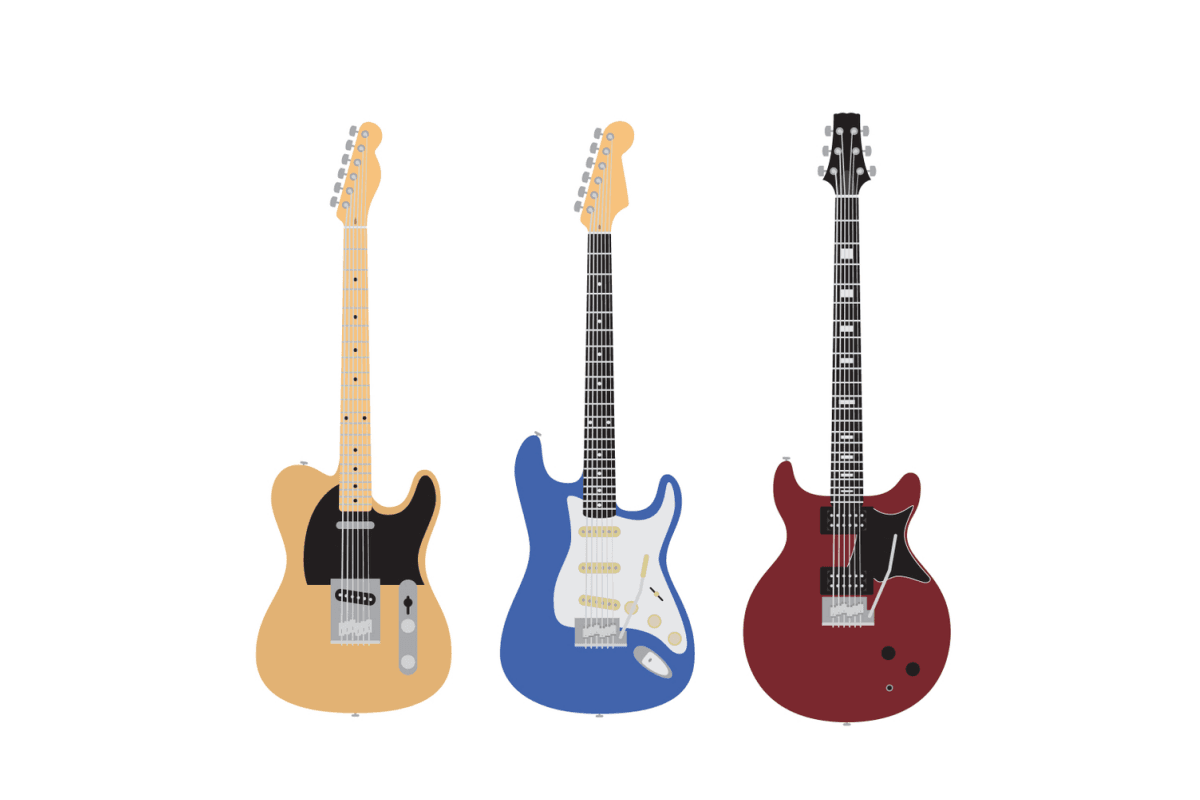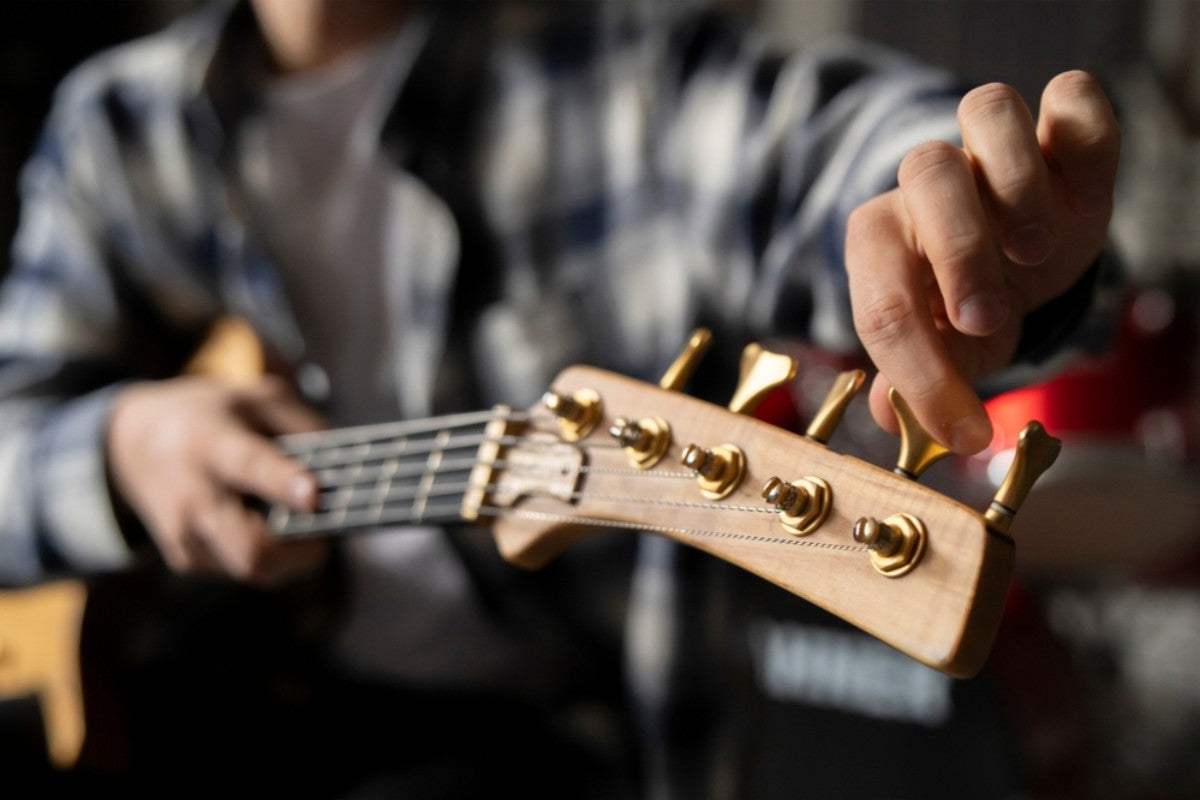The most iconic musical instrument of the 20th century changed the music landscape forever. If you want to peep behind the curtain at how magic happens, you’re in the right place.
This is the ultimate guide to how an electric guitar works step by step. We’ll go deep into every topic and dissect the instrument to a level you haven’t seen before.
By the end of this article, you’ll know how a simple electric guitar works. Furthermore, you’ll have a clear understanding of why this 6-string wonder changed the world one hit record at a time.
Jump on, let’s do this!
Electric Guitar Parts
To talk about how an electric guitar works, it’s paramount to talk about how an electric guitar is made. For that, we need to start naming guitar parts and what does what.
Necks & Bodies
When you think about how an electric guitar is made, you probably think of machinery to cut and shape wood. Well, you’d be right, because, arguably, 99% of electric guitars are made of wood. See what types of wood are best for electric guitars?
The wooden parts are the neck and the body.
The neck can be made of many different tone woods. Maple and mahogany are the most common ones. On top, it features a fretboard, that can be made of many materials. Rosewood, maple, and ebony are the most common.
The fretboard, as its name indicates, has the frets that divide it into notes, one semitone at a time.
The neck includes the fretboard and the headstock, where most guitars feature tuners. That’s when you can change the pitch of your guitar.
Headless guitars feature tuners on the bottom, at the bridge. (See are headless guitars coming back?)
The neck is then attached to the body using one of the following three techniques:
• Set-neck – This technique is used by Gibson, PRS (most of them), and other brands. The guitar’s body has a slot that fits the bottom part of the neck perfectly. The luthier adds the glue, and the neck is set into place.
• Neck-through – In this technique, the neck continues through the body all the way to the bottom of the guitar’s body. You could think of it as a long piece of wood with added “wings”. The best-known neck-through model is the Gibson Firebird.
• Bolt-on – Bolt-on guitars are the most common. This is the cheapest way to attach the body to the neck. You only need four bolts and a neckplate.
The material and building techniques used on the guitar body and neck affect how an electric guitar sounds without an amp and make most of the money an electric guitar costs to build.
What makes the sound of an electric guitar is what comes up next, so keep reading to find out.
Electric Guitar Pickups
Electric guitar pickups are the heart and soul of electric guitars. Once you understand how an electric guitar pickup works, you’ll know why. Read the basics of electric guitar pickups to know more.
So, let’s begin with a question, what does an electric guitar need to work? Well, it needs electricity, because it’s an electric guitar.
But how can we create electricity?
After plugging the guitar, you need to alter the magnetic field of the pickups to create electricity and then turn it into sound.
I know it sounds difficult, but since guitar pickups are basically magnets wrapped in coil wire, and your guitar’s strings are made of a ferrous material, all you need to do is pluck the strings.
String motion is translated into electricity by the Faraday principle and goes through the pickup’s cable through the electronics and out through the jack.
Electric guitar pickups are divided into categories, the ones you should remember are:
• Single-Coil pickups – These are the pickups Leo invented for his guitars and are what you’d likely find on a Stratocaster, Telecaster, and such. They tend to sound glass-like clean, have a strong treble response, and generate a 60-cycle hum.
• Humbucker Pickups – Humbucker pickups were created in 1957 by Seth Lover for Gibson. These pickups, as their name indicates, don’t generate hum, sound more powerful, have a rounder, thicker low end, and tend to overdrive amplifiers more easily. You can read guitar pickup 101 - single-coil vs humbucker pickups to know more.
That answers how an electric guitar pickup works, but it doesn’t answer how an electric guitar produces sound, for that, you’ll need to read to the end.
Bridges, Tuners, and Tremolos
These guitar parts are also known as hardware. Yes, the electric guitar is made of wood and needs some metal too. Let’s divide our response into these parts.
Tuners
Tuning pegs or simply tuners are what help you keep your guitar in tune. How do electric guitar tuners work? I’m glad you asked, an electric guitar tuner works by stretching or loosening your guitar’s string to find a particular pitch.
These small, mechanical apparatuses usually have a cylinder to which the string is attached. Then, by turning the tuning peg you either decrease or increase the tension, modifying the pitch.
Bridges & Tremolos
The bridge in an electric guitar may or may not be a tremolo unit. That said, every electric guitar needs a bridge, it’s a part of how the electric guitar works. Indeed, the string goes from the tuners to the guitar bridge where it’s kept in place by the ball end.
Tremolo units allow the player to bend the string up and down in pitch by moving a bar. There are many different iterations of this concept, you can have a Bigsby tremolo, a synchronized one (like you’d find in a Stratocaster), a Floyd Rose tremolo, a double-locking, double-action unit, or a Panorama tremolo as you’d find on Jazzmasters or Jaguars.
The bridge on an electric guitar, with or without tremolo, is the place where you regulate string length, a necessary step in an electric guitar setup.
Jacks, Circuits, Caps, Pots, And Switches
We’ve all looked down at our instruments hanging from the strap after turning on and off various pedals and wondered how the tone control on an electric guitar works. Well, we’ve talked about how an electric guitar gets power or generates electricity.
That electricity, we could call it signal from now on, goes through the guitar’s controls all the way to the output jack where it meets the cable that will take it to the amplifier.
What do the controls on an electric guitar do?
Volume Pot
Let’s start with the volume pot. With it, you can reduce or increase the pickup’s gain. This means that, the closer you get to 10, the more gain the guitar will have. As you roll it off in the opposite direction, you’ll decrease gain until it goes completely silent. You can read to know everything about pots and caps.
Tone Pot
After the volume, the signal goes to the tone pot. This is the same as the above, but it has a capacitor wired, so instead of cutting off gain, it cuts off the treble from the original signal. Therefore, as you turn it up, closer to 10, you get brighter sounds. Turning it down gives you bassier, darker sounds.
Pickup Switch
The pickup switcher is usually a 3-way or 5-way switch, depending on the number of guitar pickups. What it does is simply toggle between what pickup or mix of pickups are active at a given time. For example, Les Paul guitars feature a 3-way switch to toggle between bridge, both, and neck pickups.
Jack
Finally, the signal reaches the jack, the slot to connect the cable to the guitar. This will allow the energy that the electric guitar generates to reach the amplifier to be, well, amplified.
The History of the Electric Guitar, The Solution for Volume
A guide to the electric guitar and how it works needs to start from the beginning. As with most inventions in the history of humanity, it starts with a need.
Let me put you in the picture, the year is 1930, and guitar players are struggling to be heard in big bands. Imagine competing against a piano player, a horn section, a double bass, and drums without an amp.
Well, electric guitars solved that problem and put the electrical guitar on top of the food chain for decades to come
Hollow-Body Guitars
The guitars at that time were hollow-body, big jazz guitars with no pickups. The resonance that propelled the sound forward was that of the guitar’s body.
Meet Charlie Christian, the best-known electric guitar player from the early 20th century. He was one of the first players to play his guitar as a virtuoso leading a band.
Because of how an electric guitar works, volume and a hollow body aren’t best friends. If you know a little about how electric guitar physics works, you’ll know that pushing volume to a hollow-body guitar can mean loud feedback.
Moreover, that low rumble coming from the inherited big, empty body became the number-one enemy.
The guitars needed to be louder. The instrument was ready to take a step forward to take the center of the stage. A spot that was never going to leave again, of course.
The Fender Revolution
When you wonder how electric guitars work, the concept of “electric guitar” is always very close to what Leonidas Fender came up with in the late 1940s.
At the time, electric guitar making took inspiration from the archtop instruments in orchestras. Orville Gibson, whose last name might ring a bell, was making folk instruments like archtop mandolins.
Fender envisioned an electric guitar with cheap components, easily serviceable, and that could fix the feedback problem. The Fender Telecaster, which came out in 1952, is exactly that, a plank of wood (as cheap as pine) with a bolt-on maple neck (another very cheap and abundant wood) and electronics.
When compared to expensive, mahogany-made, ornamented, set-neck construction, and archtop guitars at the time required, Fender’s revolution is even more evident.
Guitars became cheaper to make and to buy. But not just that, they became more reliable, road-ready, and easy to service. If the neck of your Tele was bent or broke, you just sent it in, got another one, screwed it in, and you were good to go.
Sound-wise, the guitar also got brighter and louder. Its tone began moving toward the center of the stage.
The solid-body Telecasters, Stratocasters, Precision Bass, Jazz Bass, and the myriads of instruments that came from the Fender factory changed the history of music forever.
Furthermore, the Stratocaster, a design that remained virtually untouched for decades, is still one of the best-selling guitar shapes on the planet.
The basis for the modern electric guitars was set.
Brands like Gibson, PRS, and many others kept on experimenting with and refining this concept until they transformed it into playable works of art.
Join me to see what other revolutions took the electric guitar to modern times.
Current Times
Although the foundations for the electric guitar were set in the early 1950s, the electric guitar is, perhaps, the most common and widely researched musical instrument in the world.
So, there are many different guitar models and styles, and this is the result of players continuously pushing the boundaries of what you can do with it. Also, well the eighties happened.
Some important milestones:
• Headless Guitars – Headless guitars are the quintessential ‘80s look but have made a huge comeback in the past few years. They’re usually in the hands of virtuosos and have been improving at light speed lately.
• Floating Tremolos – The eighties needed faster, flashier, pyrotechnic shredders to make the rock and roll circus bigger. Well, thanks to Eddie Van Halen and the gang, floating tremolos helped players reach a new level of tuning stability and accuracy.
• Active Circuits/Pickups – Active electric guitar pickups and circuits require a 9v battery to work. Among other things, they are more powerful, crisp, clear, and carry more punch than most passive electric guitar pickups.
FAQs
How does an acoustic-electric guitar work?
Acoustic-electric guitars work very similarly to electric guitars. The big difference is that, in most cases, instead of picking up the string vibration through a magnetic pickup, they do it with a piezo pickup installed in the bridge.
How does an electric bass guitar work?
The principles for electric basses and electric guitars are identical.
How do nylon electric guitars work?
Nylon guitar strings can’t be captured by magnetic pickups, since they don’t disturb the magnetic field. They require piezo crystals vibrating in the bridge to create sound.
Do electric guitars need to be set up?
Yes, a regular electric guitar setup ensures the instrument always plays and sounds at its best. Wood is an organic material and very susceptible to temperature and humidity changes.
How do electric guitar strings work?
Electric guitar strings, unlike nylon strings, or classical instrument strings, come with a ball end. That little ball is what keeps the string in place at the bridge as you tighten it to reach the desired pitch.
Conclusion
By now, you must have a clear idea of how an electric guitar works. We’ve been through each of its components and gone deep into what does what. Moreover, we’ve compared different models so you can tell how different electric guitars work.
Now it’s time to apply this knowledge in the real world. So, go ahead, pick up that guitar, and put decades of hard work and relentless innovation into your art.
Happy (guitar) playing!
If you like this article, please share it!
Be sure to join our FB Group Guyker Guitar Parts VIP Group to share your ideas! You can also have connections with like-minded guitar players, Guyker updates as well as discounts information from our FB Group.




